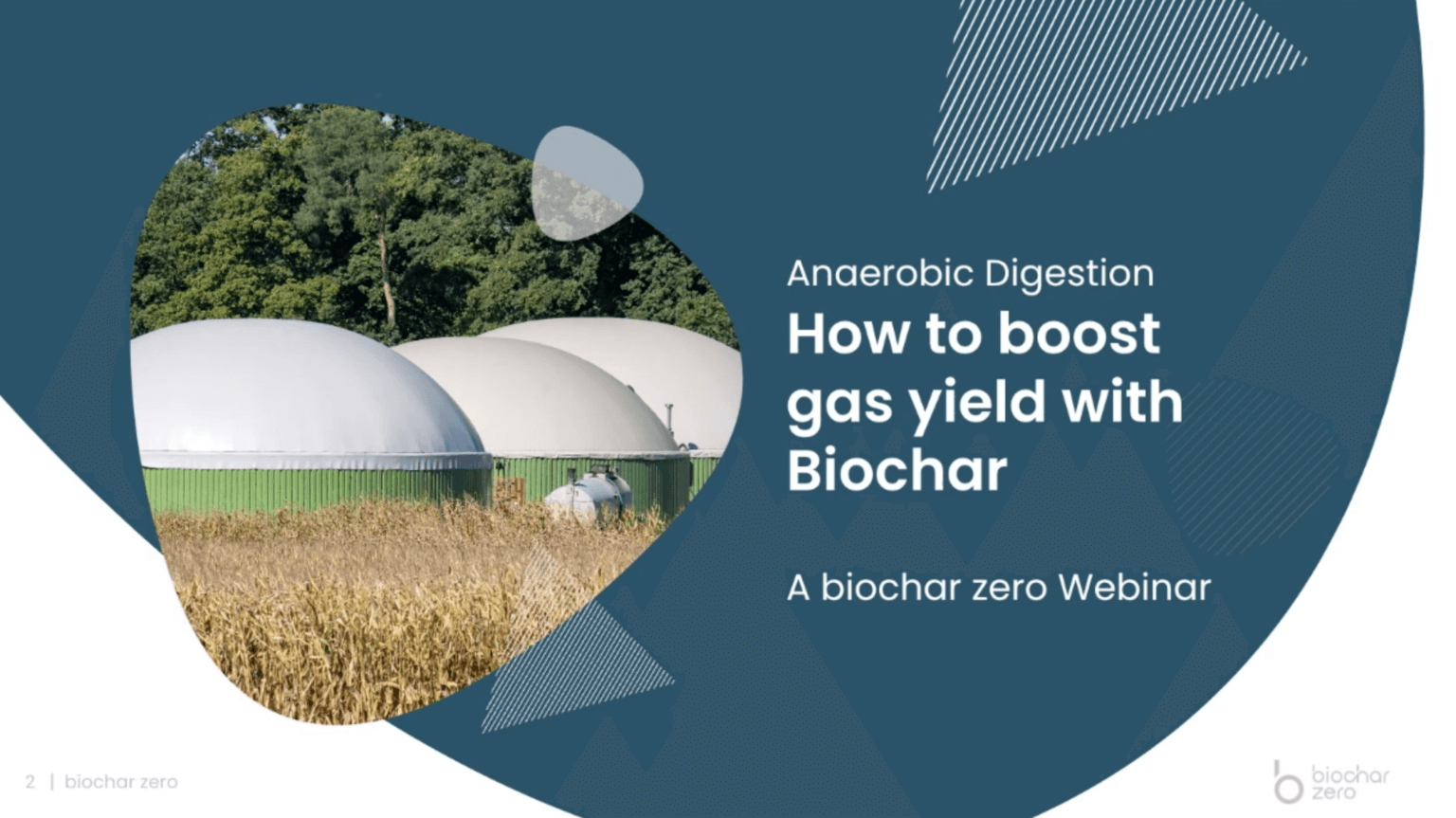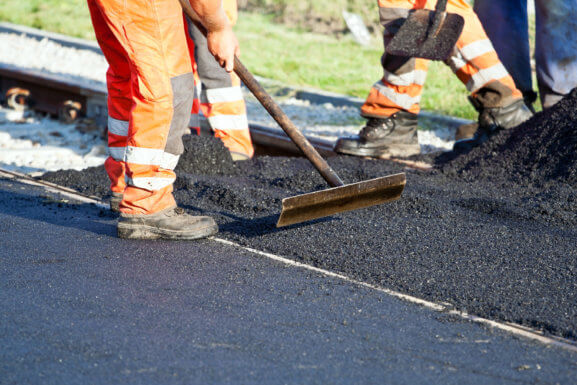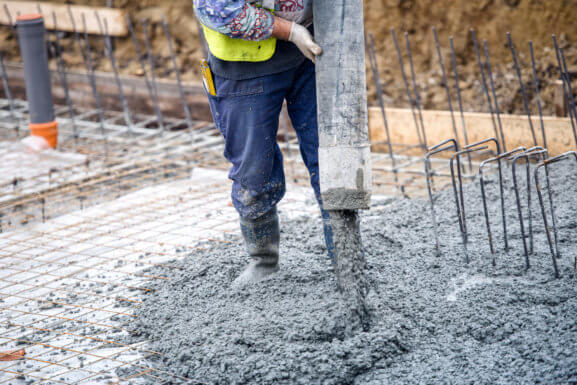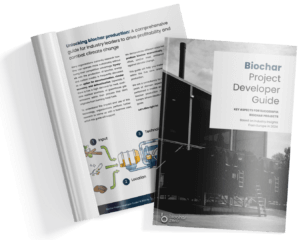Biogas production is a complex, multi-step fermentation process for producing combustible gases based on the interaction of a wide variety of microbial cultures. The anaerobic digestion industry is under increasing pressure to avoid efficiency losses. This is where biochar comes in as its specific properties make it a favorable catalyst for increasing the efficiency of the fermentation process. In addition, biochar turns the fermentation residues into effective fertilizer.
Advantages of Biochar in Biogas Plants
- Up to 20 percent1RÖDGER, Jan-Markus, et al. Steigerung des Biogasertrages durch die Zugabe von Pflanzenkohle. Müll und Abfall, 2013, 9. Jg., Nr. 13, S. 477. https://chiemgau-agrar.de/wp-content/uploads/2019/10/Artikel-Steigerung-des-Biogasertrages-durch-Pflanzenkohle.pdf more biogas yield due to:
- Increased growth surface for microorganisms
- Accumulation of methane-forming microorganisms
- Binding/adsorption of inhibitors such as ammonia, heavy metals and toxins
- Flexibilization of the plant process
- Replacement of expensive additives and auxiliary materials
- Further use for soil improvement
Anaerobic fermentation is constantly influenced by factors such as ammonia, hydrogen sulfide, high salinity and trace elements, low pH, shear forces, and temperature fluctuations2Christian Wurzer, 72. Green Carbon Webinar – Biochar use for anaerobic digestion”, published 24 March 2022 by Christian Wurzer at https://www.youtube.com/watch?v=i4wLMiqiDK0.
These advantages of biochar arise because it serves as a colonization ground as well as a conductor for the direct exchange of electrons between microorganism species. This means that methane-forming microorganisms find an excellent habitat for multiplication in the porous structure of biochar. In addition, biochar binds ammonia that is harmful to the fermentation process. Furthermore, the amount and composition of biochar can be used to control the process, as the high cation exchange capacity of biochar influences chemical and biological processes. In addition, similar to activated carbon, biochar is suitable for the adsorption of heavy metals and toxins.
Economic viability of biochar in anaerobic digestion varies greatly between plants. For some plants feasibility is only made possible by further usage of fermentation residues enriched with biochar as a soil improver and fertilizer on agricultural land. Whereas other anaerobic digestion plants become economic using biochar due to additional revenue due to increased biogas yield.
Furthermore, biochar can be a favorable alternative to other additives and catalysts. This is because “the susceptibility of the anaerobic digestion process to faults, especially at its performance limits, requires the use of various additives or auxiliary materials. Thus, the addition of expensive trace elements, especially in mono-digestion, is no longer conceivable without them.”3RÖDGER, Jan-Markus, et al. Steigerung des Biogasertrages durch die Zugabe von Pflanzenkohle. Müll und Abfall, 2013, 9. Jg., Nr. 13, S. 477 https://chiemgau-agrar.de/wp-content/uploads/2019/10/Artikel-Steigerung-des-Biogasertrages-durch-Pflanzenkohle.pdf
Biochar is an effective way to store carbon in the long-term. Thus, the application of biochar leads to negative emissions and carbon removal certificates can be sold.
Degree of Development
Zhao et.al. describe the challenges faced by anaerobic digestion and point out a solution: “Anaerobic digestion (AD4anaerobic digestion) technology still faces several challenges, including low methane productivity, unstable operating efficiency, and undesirable degradation of refractory materials. Biochar has recently been incorporated into the AD process as a promising alternative to increase methane production.”5Weixin Zhao, Haizhou Yang, Shufei He, Qingliang Zhao, Liangliang Wei, A review of biochar in anaerobic digestion to improve biogas production: Performances, mechanisms and economic assessments, Bioresource Technology, Volume 341, 2021, 125797, ISSN 0960-8524, https://doi.org/10.1016/j.biortech.2021.125797
Usage of biochar in anaerobic digestion is not yet widespread, except for numerous user farms in Swiss, and a handful of users in Austria & Germany. There are research projects on biogas yield increase through biochar, as well as model plants, which elicit the advantages of combining biogas with biochar production plants at one site.
Application
Biochar for biogas can be added to the main fermentation as well as to the secondary fermentation.
According to Roedger et al., adding biochar additive for AD plants to the main fermenter increases gas yield by 9%. However, if the biochar additive for AD plants is added to the secondary fermenter, yield increases of 13-24% can be achieved6RÖDGER, Jan-Markus, et al. Steigerung des Biogasertrages durch die Zugabe von Pflanzenkohle. Müll und Abfall, 2013, 9. Jg., Nr. 13, S. 477. https://chiemgau-agrar.de/wp-content/uploads/2019/10/Artikel-Steigerung-des-Biogasertrages-durch-Pflanzenkohle.pdf. Outside the laboratory scale, practical application shows an increase in yield of up to 10%.
In the aforementioned scientific study, the best results were obtained with coarse-grained biochar particles7RÖDGER, Jan-Markus, et al. Steigerung des Biogasertrages durch die Zugabe von Pflanzenkohle. Müll und Abfall, 2013, 9. Jg., Nr. 13, S. 477. https://chiemgau-agrar.de/wp-content/uploads/2019/10/Artikel-Steigerung-des-Biogasertrages-durch-Pflanzenkohle.pdf. This is reflected by the range of currently available biochar products for biogas production: biochar substrates with a rather large particle size between approx. 0.5 – 2 cm are offered for biogas treatment.
Certain biochar with a low H/C ratio are permanent in its C-content, however, it is not clear yet if the carbon content is completely preserved during fermentation and enhances the value of the fermentation residues to be used in agriculture.
Dosage
As a permanent solution, 0.1 – 0.5% biochar is recommended to be applied to the biogas process in relation to the dry mass used. In literature, a regular injection cycle of 14 days is described. Practitioners use differen methods of introduction: either the biochar is added directly to the input material, or it is added manually or automated into the fermenter or secondary fermentation.

Approval & Certification
In addition to the use of the biochar for biogas production, the subsequent use of the biochar-containing digestate in an agricultural context is also relevant for certification.
The use of biochar-containing digestate in an agricultural context is allowed in the EU as well as in Switzerland. In the EU, the use of digestate and biochar in fertilizer products is regulated in the updated Düngemittelverordnung (Regulation 2019/1009).
If the biochar-containing digestate is used agriculturally as a fermentation fertilizer, the harmlessness must be certified, since pollutants such as “PAHs, but also dioxins and heavy metals could enter the human food chain and accumulate permanently in soils”8EBC (2012-2022) ‘European Biochar Certificate – Richtlinien für die Zertifizierung von Pflanzenkohle’, Ithaka Institute, Arbaz, Switzerland. http://www.european-biochar.org Version 10.1G vom 10. Januar 2022. In Europe, certification is offered by the European Biochar Consortium (EBC). Biochar for conventional agriculture is certified therein according to EBC-Agro, and for organic agriculture in the category EBC-AgroBio, the difference being stricter heavy metal and PAH limits for the latter9EBC (2012-2022) ‘European Biochar Certificate – Richtlinien für die Zertifizierung von Pflanzenkohle’, Ithaka Institute, Arbaz, Switzerland. http://www.european-biochar.org Version 10.1G vom 10. Januar 2022.


Sources




